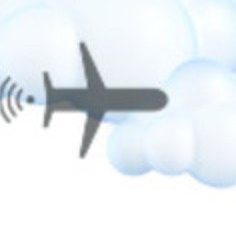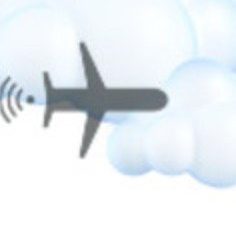Connections Aloft
August 30, 2017

Inflight entertainment as a concept goes back to the earliest days of commercial aviation; the very first inflight movie was called Howdy Chicago and it was screened on an Aeromarine Airways flight in 1921. However it would be decades and many more or less unsuccessful attempts to bring inflight entertainment and connectivity to its present technological state of the art.
Today for the business traveler, the most critical development is connectivity – which means the ability to surf the web, take phone calls, send e-mails, and have an online experience similar to one they would expect on the ground. So increasingly inflight systems have turned to satellite technology – both to provide the kind of speed and reliability users expect, and to provide coverage over those long transoceanic routes where ground-based systems are simply not feasible.
In the world of satellites, there are two different wavelength spectrums that deliver broadband to the aircraft from orbit: Ka and Ku. There’s a debate about which is best, and pros and cons for both. However for travelers, the choice is largely academic – both power the WiFi onboard, and there is unlikely to be differences in price as the market will determine this.
The dominant players in the inflight connectivity market (both satellite and air-to-ground) are Gogo, Panasonic, SITA, Global Eagle Entertainment and ViaSat Inc. Market researchers Provisions Networks says these top five players own about 65 percent of the market. Pioneer Gogo – heretofore known for its air-to-ground technology – has recently ventured into the satellite market with the launch of its next generation 2Ku satellite technology, which it says will deliver speeds of up to 100 Mbps to the aircraft – compared with Gogo’s current offering which limps along at speeds reportedly as slow as 3 Mbps.
However the move hasn’t kept Gogo customers such as American and United from drifting toward a multi-provider strategy using one system on part of the fleet and a different one on other aircraft. Of course, the driver in all this is market demand; the providers’ customers, the airlines, are feeling the squeeze from their customers, the passengers, to provide faster and more reliable inflight connectivity.
Here’s a roundup of what the world’s airlines are working on to keep you online while you’re on board
British Airways
BA has launched its new long-haul WiFi service, with the technology initially being offered on one 747 aircraft, and a second due to be fitted in July.
Access is available across two connection speeds – Simply Connect for basic web browsing, and Connect Plus which can handle video streaming. Prices range from £4.99 ($6.50) to £23.99 ($31) depending on type and duration of connection. ba.com
Air France KLM
Air France now offers inflight WiFi on its newest 787-9 aircraft, two of which have been delivered since the start of this year. Air France’s sister carrier KLM already offers WiFi on its fleet of Boeing Dreamliner aircraft.
The group also plans to roll out the technology to 124 A330 and 777 aircraft, starting from the end of 2017. airfrance.co.uk, klm.com
Lufthansa
The German carrier is gradually expanding its FlyNet WiFi offering across its short-haul fleet (and those of subsidiaries Austrian and Eurowings), with the technology being rolled out to “an ever growing number of flights within Europe and on flights to and from North Africa and the Middle East” through to the middle of 2018.
Lufthansa also offers WiFi on many of its long-haul aircraft, including the latest A350-900s, three of which have been delivered since the start of this year. lufthansa.com, austrian.com
Cathay Pacific
The flag carrier launched its new inflight WiFi offering on its new A350 aircraft last year, with 14 of the widebody aircraft now in service on routes including Hong Kong-Gatwick.
Price range from $9.95 for one hour’s access, to $12.95 for connectivity throughout the flight (on routes of six hours or less) and $19.95 on routes over six hours. cathaypacific.com
Qantas
The Australian carrier has begun free inflight WiFi trials on one of its domestic 737-800 aircraft, with Qantas stating the service offers speeds “up to 10 times faster than conventional on-board WiFi.” Inflight testing is expected to be completed by the middle of the year, with the carrier’s fleet of 80 A330 and 737 aircraft fitted with the technology by the end of 2018. qantas.com.au
Finnair
Wifi is now available on all of Finnair’s new A350s, as well as “most of our A330s,” according to the carrier.
Access can be purchased for €7.95 ($9) for one hour, €11.95 ($14) for three hours or €19.95 ($23.50) for the full duration of the flight. Business class passengers and Finnair Plus Gold members get one hour’s complimentary Internet access, while Finnair Plus Platinum enjoy free access throughout the flight. finnair.com
Swiss
WiFi technology is fitted to Swiss’ fleet of Airbus A330-300s, as well as the carrier’s fleet of 777-300ER aircraft, of which eight have so far been delivered.
Prices range from nine to 39 Swiss Francs depending on data usage, with the carrier stating that “the speed is similar to all public WiFi connections on the ground.” swiss.com
Air New Zealand
The Kiwi carrier is expected to start rolling out its inflight WiFi service beginning in the second half of this year. Flights between Australia and New Zealand will be the first to see the service, followed by Tasman, Pacific Island and long-haul services from the end of 2017, and domestic services starting in 2018.
The technology will be supplied by Inmarsat’s new global GX satellite constellation, and integrated with ANZ’s Panasonic Avionics system. airnewzealand.co.uk
Air Canada
The Canadian flag carrier has announced plans to extend its inflight WiFi offering to the airline’s wide-body fleet, with connectivity being provided by Gogo’s 2Ku satellite technology.
Air Canada already offers WiFi on all of its 129-strong narrow-body fleet serving North America, including Embraer jets and the carrier’s fleet of A319, A320 and A321 aircraft. aircanada.com
Virgin Australia
The carrier began a three-month trial of inflight WiFi on one of its 737-800s in April operating on domestic routes. During the trial period passengers were able to connect for free.
Virgin Australia said that it plans to install WiFi across its fleet of 737-800s, Airbus A330s and 777s operating domestic and international services following the completion of the trials. The carrier says following the test period and listening to customer feedback, it would “finalize its business model” for the service. virginaustralia.com
Emirates
Emirates has restructured its inflight WiFi offering, doubling the amount of free data for economy passengers and non-Skywards members to 20MB. The 20MB of free data must be used with the first two hours of logging on and additional usage will cost.
Skywards Platinum and Gold members now get unlimited data usage throughout the flight, regardless of class of travel, while all Skywards members traveling in first and business class also get complimentary service. emirates.com
ANA
All Nippon Airways’ inflight WiFi offering gives fliers in all classes access to functions such as web browsing and e-mail functions. Video streaming is not supported, and image loading is likely to burn through your data quite quickly.
For travelers flying on ANA’s 777-300ER and 767-300ER, the service is only available when flying over transoceanic airspace and countries that permit the use of satellite activity, while 787 and A320 inflight connectivity is available in all airspaces. ana.co.jp
China Airlines
Inflight WiFi on China Airlines has no data limit and while the overall speed may make certain functions difficult, this does provide reassurance for those who tend to quickly eat through data that they won’t be prematurely cut off from the service.
Purchasing WiFi can be done on the flight or ahead of time via the airline’s website. The service costs NT$350 ($11.60) for one hour, NT$500 ($16.50) for three hours, or NT$650 ($21.50) for 24 hours. china-airlines.com
Eva Air
It is worth noting that Taiwan-based Eva Air’s service provider is currently applying for an operating permit with the Chinese government, however until then Internet connectivity, unfortunately, gets temporarily disconnected when flying over mainland China, Hong Kong and Macau with the carrier.
On the plus side, however, for longer journeys across multiple segments, travelers can conveniently reconnect to Eva Air’s WiFi network using the same account information, provided the ensuing leg is also operated by an Eva WiFi-enabled aircraft. evaair.com
Japan Airlines
Japan Airlines offers inflight WiFi based on overall duration used, with its 24-hour offering also including connecting flights for 24 hours from the initial log-in. Data caps are also not present regardless of payment category.
Check the JAL website for a full list of the routes on which WiFi is offered; many are only available until/from certain dates. The airline’s fleet of 787s is also not fully equipped with WiFi, so connectivity is not guaranteed, though travelers on these aircraft can check whether inflight WiFi will be available on their flight the day before they travel. jal.co.jp
Singapore Airlines
Singapore Airlines has a somewhat complicated pricing structure regarding its inflight WiFi, owing largely to its partnership with two different providers, Onair and Panasonic. As such, price plans come in two variations, depending on provider and the type of aircraft – volume based or time based.
What’s also worth noting is that volume-based plans are only valid for the leg on which they are purchased. An onward journey, even if it is on the next sector of the same flight, requires another purchase. Time-based purchases, however, can be transferred across multi-sector flights. singaporeair.com
By Mark Caswell & Craig Bright




